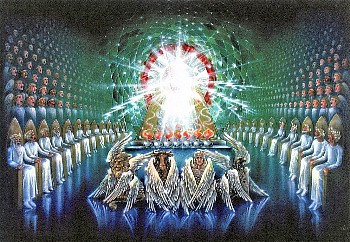
" And out of the throne proceeded lightnings and thunderings and voices: and there were seven lamps of fire burning before the throne, which are the seven spirits of God" Rev 4:5 Re: Seven Spirits Of God? by DeepSight( m): 3:35pm On Dec 26, 2009 Tammuz, Ishtar's husband, has been making merry while she has been dead, and so the goddess sends Tammuz to Ereshkigal. Her release is, however, granted only under the condition that she find someone to replace her in the underworld. Then Ishtar passes back through the seven gates, getting one article of clothing back at each gate, and is fully clothed as she exits the last gate. Asu-shu-namir sprinkles Ishtar with this water, reviving her. Ereshkigal, having promised to grant Asu-shu-namir's wish, is enraged when she hears the demand, but she has to give him the water of life. Ea creates a eunuch called Asu-shu-namir and sends him to Ereshkigal, telling him to invoke "the name of the great gods" against her and to ask for the bag containing the waters of life. Papsukkal, the messenger-god, reports the situation to Ea, king of the gods. After Ishtar descends to the underworld, all sexual activity ceases on earth. In a rage, Ishtar throws herself at Ereshkigal, goddess of the underworld but Ereshkigal orders her servant Namtar to imprison Ishtar and unleash sixty diseases against her. When she finally passes the seventh gate, she is naked. At each gate, Ishtar has to shed an article of clothing. When Ishtar approaches the gates of the underworld, the gatekeeper lets Ishtar pass through the seven gates, opening one gate at a time. In this myth, Ishtar decides to visit her sister, Ereshkigal, in the underworld. The Dance of the Seven Veils is also thought to have originated with the myth of the goddess Ishtar and the god Tammuz of Assyrian and Babylonian lore. These "seven veils" are, in order, Dreams, Reason, Passion, Bliss, Courage, Compassion, and Knowledge. The idea of "the seven veils of mystical experience" actually predates Wilde's play. Modern day mystics see the dance of the seven veils and the story of Inanna's descent as a metaphor for enlightenment, shedding "veils" of illusion on the path to deeper spirituality of self-realization. Therefore, there are seven major gods in many ancient religions, and the number seven appears in many myths and classification systems. The number seven was significant to the ancients, as it is the number of heavenly bodies visible to the naked eye without a telescope: Sun, Moon, Mercury, Venus, Mars, Saturn and Jupiter. In this myth, the goddess descends into the underworld and must pass through seven gates on her journey, at each of which she must surrender a piece of jewelry or a symbol of her royalty. Some have claimed that the dance of the seven veils has its roots in an ancient myth about the Sumerian goddess Inanna or the Babylonian goddess Ishtar. Most Latin-based languages connect each day of the week with one of the seven "planets" of the ancient times: Sun, Moon, Mercury, Venus, Mars, Jupiter, and Saturn. Mercury (quicksilver) dominated by Mercury ☿ ( ) Although they occasionally have a symbol of their own (denoted by also, they were usually symbolized by the planet's symbol. Planetary metals were "dominated" or "ruled" by one of the seven planets known by the ancients.


Of the seven metals, five can be found in their native states, e.g., gold, silver, copper, iron (from meteors) and mercury. These metals were known to the Mesopotamians, Egyptians, Greeks and the Romans. 1 Wisdom hath builded her house, she hath hewn out her seven pillars:


 0 kommentar(er)
0 kommentar(er)
